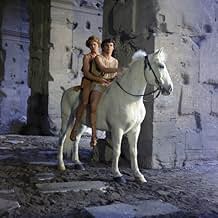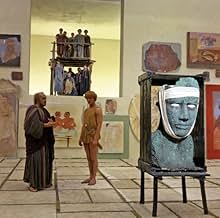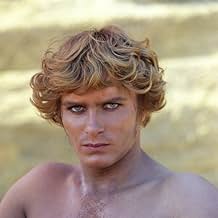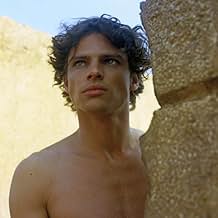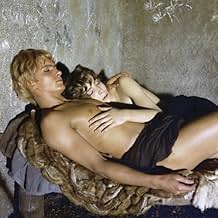A series of disjointed mythical tales set in first-century Rome.A series of disjointed mythical tales set in first-century Rome.A series of disjointed mythical tales set in first-century Rome.
- Nominated for 1 Oscar
- 5 wins & 8 nominations total
Mario Romagnoli
- Trimalcione
- (as Il Moro)
Danika La Loggia
- Scintilla
- (as Danica la Loggia)
Lucia Bosè
- La matrona
- (as Lucia Bosé)
Joseph Wheeler
- Il suicida
- (as Joseph Weelher)
George Eastman
- Minotauro
- (as Luigi Montefiori)
Featured reviews
For a long time I have been interested in seeing the work of Fellini, and it would seem Satyricon would be my first taste, but it was not one bit appetising. Many opinions vary on this film, some hail it as a masterpiece, others pass it off as a self-indulgent failure, well I'm afraid I'm with the latter group. Satyricon is a slow, bleak and slightly disturbing look at depraved ancient Rome, as two young men fight for the attention of a young slave boy, they are involved in a series of bizarre, erotic and non-linear escapades. I think I got to the emperor's pre-funeral party (about an hour in) before I began tiring of the film, it was just too much to take in and not hardly as interesting as I had thought, also the morals of the film where a bit troubling, now I am no prude but you only have to look at the lecherous cover art to see what I'm talking about. Don't get me wrong, the film is not that graphic, but there is an unsettling air that runs through it. I'm not going to abandon Fellini, having spoken to others who where also bored and puzzled by Satyricon but have enjoyed his other works, I think I may just have to start with one of his earlier films.
The cinema of the silent and Fascist eras in Italy was characterised by epic movies with mostly mythology-inspired themes. Mussolini, who came into power in 1922, the founder of Cinecittà, did not underestimate the importance of cinema as a means of communicating with the masses. Fellini notoriously called Giulietta Masina's titular character in Notti di Cabiria after the 1913 movie "Cabiria" by Giovanni Pastrone, a grand production with a visual flair not so dissimilar to Satyricon. Literally hundreds of characters parade in front of the camera in this visual orgy of a movie, evoking the memory of lost "Kolossals", or gargantuan budget productions.
Fellini's movie was only loosely inspired by its literary source, Petronius's Satyricon. The nominal "plot" follows two young Roman men, the blonde Encolpio and the brunette Ascilto, introduced as rivals in love for the coquettish, androgynous slave-boy Gitone. When the latter chooses to be with Ascilto, the spurned lover Encolpio becomes involved in a series of adventures, all narrated with a familiar (to Fellini lovers), non-linear narrative structure with temporal inconsistencies and dreamlike, sudden changes of setting and mood. Encolpio attends the decadent banquet of a former slave, Trimalcione, now filthy rich. Eumolpo, an impoverished poet whom Encolpio meets on the way there, despises the wealthy man, all the more so for being rich and for having the nerve to also call himself a poet. The faint-hearted may at this point find much to object to the lasciviousness with which the banquet guests eat, drink and act lustful with one another is anything but subtle. The Trimalcione sequences felt to me like a satirical commentary on the rise of the nouveau riche in 1960s Italy. A highlight of the banquet scene is the story that the host narrates. It tells of a young widow, an oasis of cinematic calm in among the strident cacophony of the rest of the movie.
In a narrative passage which is reminiscent of the rhythm of dreams (typical of late Fellini, betraying his Jungian tendencies), Encolpio ends up captured by the pirate Lica, who takes him on board his ship. This is where the young buck meets Ascilto and Gitone again, also captives of the tyrant. At this point I was especially impressed with the extraordinary talent of Donati as a set designer. The ship wasn't built to look like a recognisable ship at all, but was rather like a symbol of one. Needless to say that no matter how abstract it was, you knew it was a ship, as its "ship-like essence" was all there! When Encolpio is beaten in a duel with Lica, he is forced to marry the pirate in a ceremony celebrated on the deck. But Lica is decapitated by some political rivals when a new Emperor takes over. "Everything changes so that it can all stay the same" is a cynical saying you still often hear in Italy. It refers to the fact that one greedy ruler will succeed another in a ruthless battle for power and privilege. That's when you realise Satyricon is a brilliant satire of modern society as well.
Encolpio and Ascilto then wander into the aristocratic home of a husband and wife who've just freed their slaves and committed suicide through bleeding themselves to death (a symbol of the death of aristocracy while the nouveau riche are getting fat?). After a threesome with a slave-girl who was left behind in the dead couple's empty home, the two young men attend a sort of sanctuary where an old man exploits the alleged healing powers of a very sick-looking, ethereal hermaphrodite child. Worshippers, lepers, cripples and sick people of all descriptions flock to ask for favours off the allegedly divine hermaphrodite. If this isn't a dark, ruthless parody of the Catholic practice of worshipping saints' relics, I don't know what is!
Subsequently captured by some soldiers, Encolpio is defeated by the Minotaur in his mythological labyrinth. The young man's life is spared when he literally talks the Minotaur out of slaying him, in a scene which is both post-modern and subtly comical. But a new humiliation is in store for Encolpio, which has him set off looking for the sorceress Enotea. Her story is told in flashback. Yet again, the prudish and faint of heart will not find the scenes of a cursed woman literally "giving birth" to fire through her vagina as their cup of tea! Though admittedly unsavoury, I also find such elements to be archetypically symbolic, and ultimately fascinating.
After visiting Enotea, Encolpio witnesses the killing of his friend Ascilto. Desperately upset, Encolpio decides to set sail for Africa on a merchant ship owned by the once-poor and bitter old poet Eumolpo, now as filthy rich and decadent as Trimalcione, whom he had once criticised for his parvenu vulgarity. When the old poet dies, he leaves a testament stating that whoever will eat his corpse will have a share of his wealth - basically, inheritance by cannibalism! Encolpio refuses the deal, while a group of greedy Roman dignitaries are shown chewing on what must obviously be the dead poet's tough old flesh, looking like so many fat cows chewing on their cuds. If a satire of a stagnant and greedy society was ever more potent and cutting than this, I would really like to hear about it!
Fellini himself defined this movie as being "Science fiction of the past". The movie's complete and intentional artifice, its occasionally obscure symbolism and gallery of grotesque portraits and strident soundtrack may not be everyone's thing. What is especially unsettling about Satyricon is that the viewer is led into a realm in which you have no idea what boundaries might be crossed. That's exactly why this is a perfect portrayal of an epoch of complete moral decadence - it drags the viewer into the exact same realm of uncertainty that the characters experience.
Fellini's movie was only loosely inspired by its literary source, Petronius's Satyricon. The nominal "plot" follows two young Roman men, the blonde Encolpio and the brunette Ascilto, introduced as rivals in love for the coquettish, androgynous slave-boy Gitone. When the latter chooses to be with Ascilto, the spurned lover Encolpio becomes involved in a series of adventures, all narrated with a familiar (to Fellini lovers), non-linear narrative structure with temporal inconsistencies and dreamlike, sudden changes of setting and mood. Encolpio attends the decadent banquet of a former slave, Trimalcione, now filthy rich. Eumolpo, an impoverished poet whom Encolpio meets on the way there, despises the wealthy man, all the more so for being rich and for having the nerve to also call himself a poet. The faint-hearted may at this point find much to object to the lasciviousness with which the banquet guests eat, drink and act lustful with one another is anything but subtle. The Trimalcione sequences felt to me like a satirical commentary on the rise of the nouveau riche in 1960s Italy. A highlight of the banquet scene is the story that the host narrates. It tells of a young widow, an oasis of cinematic calm in among the strident cacophony of the rest of the movie.
In a narrative passage which is reminiscent of the rhythm of dreams (typical of late Fellini, betraying his Jungian tendencies), Encolpio ends up captured by the pirate Lica, who takes him on board his ship. This is where the young buck meets Ascilto and Gitone again, also captives of the tyrant. At this point I was especially impressed with the extraordinary talent of Donati as a set designer. The ship wasn't built to look like a recognisable ship at all, but was rather like a symbol of one. Needless to say that no matter how abstract it was, you knew it was a ship, as its "ship-like essence" was all there! When Encolpio is beaten in a duel with Lica, he is forced to marry the pirate in a ceremony celebrated on the deck. But Lica is decapitated by some political rivals when a new Emperor takes over. "Everything changes so that it can all stay the same" is a cynical saying you still often hear in Italy. It refers to the fact that one greedy ruler will succeed another in a ruthless battle for power and privilege. That's when you realise Satyricon is a brilliant satire of modern society as well.
Encolpio and Ascilto then wander into the aristocratic home of a husband and wife who've just freed their slaves and committed suicide through bleeding themselves to death (a symbol of the death of aristocracy while the nouveau riche are getting fat?). After a threesome with a slave-girl who was left behind in the dead couple's empty home, the two young men attend a sort of sanctuary where an old man exploits the alleged healing powers of a very sick-looking, ethereal hermaphrodite child. Worshippers, lepers, cripples and sick people of all descriptions flock to ask for favours off the allegedly divine hermaphrodite. If this isn't a dark, ruthless parody of the Catholic practice of worshipping saints' relics, I don't know what is!
Subsequently captured by some soldiers, Encolpio is defeated by the Minotaur in his mythological labyrinth. The young man's life is spared when he literally talks the Minotaur out of slaying him, in a scene which is both post-modern and subtly comical. But a new humiliation is in store for Encolpio, which has him set off looking for the sorceress Enotea. Her story is told in flashback. Yet again, the prudish and faint of heart will not find the scenes of a cursed woman literally "giving birth" to fire through her vagina as their cup of tea! Though admittedly unsavoury, I also find such elements to be archetypically symbolic, and ultimately fascinating.
After visiting Enotea, Encolpio witnesses the killing of his friend Ascilto. Desperately upset, Encolpio decides to set sail for Africa on a merchant ship owned by the once-poor and bitter old poet Eumolpo, now as filthy rich and decadent as Trimalcione, whom he had once criticised for his parvenu vulgarity. When the old poet dies, he leaves a testament stating that whoever will eat his corpse will have a share of his wealth - basically, inheritance by cannibalism! Encolpio refuses the deal, while a group of greedy Roman dignitaries are shown chewing on what must obviously be the dead poet's tough old flesh, looking like so many fat cows chewing on their cuds. If a satire of a stagnant and greedy society was ever more potent and cutting than this, I would really like to hear about it!
Fellini himself defined this movie as being "Science fiction of the past". The movie's complete and intentional artifice, its occasionally obscure symbolism and gallery of grotesque portraits and strident soundtrack may not be everyone's thing. What is especially unsettling about Satyricon is that the viewer is led into a realm in which you have no idea what boundaries might be crossed. That's exactly why this is a perfect portrayal of an epoch of complete moral decadence - it drags the viewer into the exact same realm of uncertainty that the characters experience.
Fellini called his "Satyricon" a science fiction film projected into the past. His expressive portrait of ancient Rome is a richly ornamented fresco of contrasts; variations within a select kaleidoscope of opposites related to the sacred, the pure, the just, and the beautiful.
Reportedly a free adaptation of the now fragmentary writings of Petronius, the film also makes fleeting references to various scattered works and myths of antiquity. Even the language is a blend of various dialects and accents, effectively brewed together into a type of "primordial soup."
The film features a young man named Encolpio and his sometime friend Ascilto; both of whom seem to prefer participatory experience as a means to finding meaning in life while primarily disregarding status, power and possessions. Contrasting some of the film's more serene scenes with those of unrest and discord, patterns supportive of a life lived from a similar experiential perspective begin to emerge. Some examples are as follows:
During the "Death to the Classics" scene, the poet Eumolpo says that the arts have declined because the desire for "virtue" has been lost. Dialectical discussion and philosophy have been replaced with drinking, vice and monetary greed, thus preventing further creation of works of art at the same pinnacle of excellence as the classics.
Later when Eumolpo and Encolpio recline in the open field encased in an early morning mist, the elderly poet bequeaths to Encolpio a series of "natural" phenomena; among them mountains, rivers, clouds, love, tears, joy, sound, song and the voices of man...
During the "Matron of Ephesus" scene, a young woman mourning her deceased husband by starving to death in a cave has her chalk white face returned to its natural radiance after accepting the embrace of a handsome soldier. The moral being "...better to hang a 'dead' husband than to lose a 'living' lover..."
A politically doomed and suicidal married couple free their slaves whereupon a reference is made to the "sacred" earth. Their children are sent away to a place free from tyranny which will be "beautiful." Later, Encolpio and Ascilto arrive at the couple's elegant home and enjoy a night of revelry during which Encolpio quotes the "poet" as having said "...as for me I have always lived to enjoy the present moment as if it were the last sunrise..."
The tale of the beautiful Enotea and her subsequent punishment after she tricked the wizard who had professed his love for her seems to be a warning to remain "true" to expressions of affection.
Following what appears to be his final corruption after having abandoned his idealistic philosophy, Eumolpo proposes an interesting last will and testament. Those wishing to inherit a part of his worldly fortune are asked to devour his remains. Reflecting the hippie generation's symbolic scorn of rampant materialism during the shooting of this film, Encolpio and his friends smile and turn away, heading onward toward a new adventure.
The scenes of discord in the film appear to reflect issues related to social and political methods of enforced control over others. For example, during the banquet of Trimalcione, his sycophants eat, laugh, chant, dance, perform and throw objects on cue. While a captive at sea, Encolpio is made an object of entertainment for the pirate Lica. Later he is forced to battle a huge "minotaur' for the entertainment of a proconsul and his puppet court during the "gladiator prank" sequence.
Fellini makes strong use of colour symbolism in "Satyricon." The film opens in what appears to be a large Roman steam bath. There is the occasional sound of water dripping, and in Encolpio's tenement a seemingly wealthy group of party goers arrive on a small boat in the water, perhaps ready to go "slumming" with the poor. There is also a bluish tint to many of these early scenes as if they were being viewed through water. Later, during Trimalcione's feast, a flame red lens filter appears to overshadow the initial candle lit display giving the impression of an envelopment of fire. During the outdoor scenes on Lica's boat, the sound of the wind is recurrent and a blitz of snow appears providing a possible reference to the air element. Near the end of the film, Encolpio enters a maze by sliding in the dirt down a hillside. Following his battle with the minotaur, a dust storm blows as he attempts to make love with Arianna. Later, when he visits the elderly Enotea, she lets dirt fall from her clenched fists as if giving a silent reference to the earth element.
There are also many references to the supernatural and paranormal. Eyes stare into the camera as if to give reference to phantoms from antiquity looking at those presently alive as if to question. While Encolpio and Eumolpo have their discussion in the art gallery, a two tiered galley of soundless faces inexplicably passes by like unknown entities observing the men's conversation through a hole in the wall. There is a curious space-like object on the deck of Lica's ship. In addition, a momentary glimpse of supernatural visionary lights appear during the abduction of the "mystical" hermaphrodite who subsequently dies after having been exposed to the "light" of day. The film also presents a recurring symbolism of carved and imprinted heads eventually given great emphasis with Lica's startling decapitation. Perhaps the question is, has society become too obsessed with the intellect at the expense of the heart and the inherent value of the individual person? Perhaps not so for Fellini, as the entire film is intensely alive with a glorious blend of color; each face, each person, in Fellini's words, serving as an integral part of his artwork on film.
Finally, like the eternal wheel and his initial greeting, Encolpio's farewell is presented in front of a stone background and he is interrupted in mid sentence giving ....
Reportedly a free adaptation of the now fragmentary writings of Petronius, the film also makes fleeting references to various scattered works and myths of antiquity. Even the language is a blend of various dialects and accents, effectively brewed together into a type of "primordial soup."
The film features a young man named Encolpio and his sometime friend Ascilto; both of whom seem to prefer participatory experience as a means to finding meaning in life while primarily disregarding status, power and possessions. Contrasting some of the film's more serene scenes with those of unrest and discord, patterns supportive of a life lived from a similar experiential perspective begin to emerge. Some examples are as follows:
During the "Death to the Classics" scene, the poet Eumolpo says that the arts have declined because the desire for "virtue" has been lost. Dialectical discussion and philosophy have been replaced with drinking, vice and monetary greed, thus preventing further creation of works of art at the same pinnacle of excellence as the classics.
Later when Eumolpo and Encolpio recline in the open field encased in an early morning mist, the elderly poet bequeaths to Encolpio a series of "natural" phenomena; among them mountains, rivers, clouds, love, tears, joy, sound, song and the voices of man...
During the "Matron of Ephesus" scene, a young woman mourning her deceased husband by starving to death in a cave has her chalk white face returned to its natural radiance after accepting the embrace of a handsome soldier. The moral being "...better to hang a 'dead' husband than to lose a 'living' lover..."
A politically doomed and suicidal married couple free their slaves whereupon a reference is made to the "sacred" earth. Their children are sent away to a place free from tyranny which will be "beautiful." Later, Encolpio and Ascilto arrive at the couple's elegant home and enjoy a night of revelry during which Encolpio quotes the "poet" as having said "...as for me I have always lived to enjoy the present moment as if it were the last sunrise..."
The tale of the beautiful Enotea and her subsequent punishment after she tricked the wizard who had professed his love for her seems to be a warning to remain "true" to expressions of affection.
Following what appears to be his final corruption after having abandoned his idealistic philosophy, Eumolpo proposes an interesting last will and testament. Those wishing to inherit a part of his worldly fortune are asked to devour his remains. Reflecting the hippie generation's symbolic scorn of rampant materialism during the shooting of this film, Encolpio and his friends smile and turn away, heading onward toward a new adventure.
The scenes of discord in the film appear to reflect issues related to social and political methods of enforced control over others. For example, during the banquet of Trimalcione, his sycophants eat, laugh, chant, dance, perform and throw objects on cue. While a captive at sea, Encolpio is made an object of entertainment for the pirate Lica. Later he is forced to battle a huge "minotaur' for the entertainment of a proconsul and his puppet court during the "gladiator prank" sequence.
Fellini makes strong use of colour symbolism in "Satyricon." The film opens in what appears to be a large Roman steam bath. There is the occasional sound of water dripping, and in Encolpio's tenement a seemingly wealthy group of party goers arrive on a small boat in the water, perhaps ready to go "slumming" with the poor. There is also a bluish tint to many of these early scenes as if they were being viewed through water. Later, during Trimalcione's feast, a flame red lens filter appears to overshadow the initial candle lit display giving the impression of an envelopment of fire. During the outdoor scenes on Lica's boat, the sound of the wind is recurrent and a blitz of snow appears providing a possible reference to the air element. Near the end of the film, Encolpio enters a maze by sliding in the dirt down a hillside. Following his battle with the minotaur, a dust storm blows as he attempts to make love with Arianna. Later, when he visits the elderly Enotea, she lets dirt fall from her clenched fists as if giving a silent reference to the earth element.
There are also many references to the supernatural and paranormal. Eyes stare into the camera as if to give reference to phantoms from antiquity looking at those presently alive as if to question. While Encolpio and Eumolpo have their discussion in the art gallery, a two tiered galley of soundless faces inexplicably passes by like unknown entities observing the men's conversation through a hole in the wall. There is a curious space-like object on the deck of Lica's ship. In addition, a momentary glimpse of supernatural visionary lights appear during the abduction of the "mystical" hermaphrodite who subsequently dies after having been exposed to the "light" of day. The film also presents a recurring symbolism of carved and imprinted heads eventually given great emphasis with Lica's startling decapitation. Perhaps the question is, has society become too obsessed with the intellect at the expense of the heart and the inherent value of the individual person? Perhaps not so for Fellini, as the entire film is intensely alive with a glorious blend of color; each face, each person, in Fellini's words, serving as an integral part of his artwork on film.
Finally, like the eternal wheel and his initial greeting, Encolpio's farewell is presented in front of a stone background and he is interrupted in mid sentence giving ....
Fellini engages us through a tapestry of decadence during the Roman Empire with such stunning juxtapositions of exceptional images from a collapsing society that one cannot help but be reminded of our own times and its disconcert morality
The film is freely adapted from Petronius' book, which is the exploits of two young Romans, Ascilto and Encolpio, as they venture throughout the empire, indulging in both heterosexual and homosexual relationships In the course of this proliferation of sensuality, Ascilto becomes impotent and madly goes for a cure which ends in tragedy for Encolpio
The movie's treatment of the sexual decadence is remarkably powerful without being explicit In fact, in light of the mental images it presents, it actually puts on view very little on screen But there is a great quantity of mysterious whores, hedonists, gluttons, and gross indulgence in carnal pleasure In the midst of this chaos, however, there is a beautifully light reprieve as the young Romans come across a forsaken villa... A very charming slave girl has remained behind, and she playfully troubles the two men into an erotic game
Apart from that, the sex is portrayed as bizarre, tempting, suggestive of hidden secrets, violating the rules of morality, and going beyond the limit
The film is freely adapted from Petronius' book, which is the exploits of two young Romans, Ascilto and Encolpio, as they venture throughout the empire, indulging in both heterosexual and homosexual relationships In the course of this proliferation of sensuality, Ascilto becomes impotent and madly goes for a cure which ends in tragedy for Encolpio
The movie's treatment of the sexual decadence is remarkably powerful without being explicit In fact, in light of the mental images it presents, it actually puts on view very little on screen But there is a great quantity of mysterious whores, hedonists, gluttons, and gross indulgence in carnal pleasure In the midst of this chaos, however, there is a beautifully light reprieve as the young Romans come across a forsaken villa... A very charming slave girl has remained behind, and she playfully troubles the two men into an erotic game
Apart from that, the sex is portrayed as bizarre, tempting, suggestive of hidden secrets, violating the rules of morality, and going beyond the limit
I've voted 8 out of 10 for Fellini Satyricon, but I can imagine that a few people may find that to be an overly indulgent grade. Actually, I know that a few people will feel that way -- I've shown it to several friends, and they all agree it looks beautiful and manages to amuse on numerous occasions. But they don't get much more out of it. That's too bad for them. Aaaw yeah.
As Vincent Canby said in his review, from 1970 in the New York Times, 'Fellini Satyricon is its own justification'. This movie exists purely to engage on an aesthetic level. The surrealism, the carnival-of-life atmosphere, the monumental pageantry, the visual juxtaposition of beauty and ugliness, and the black humour are all the film possesses and are all it requires. I believe that Fellini's intention with this film was simply to entertain. And he was a master entertainer, no doubt.
Don't expect much in the way of characterisation, of complex plot developments, or of nifty moral expression. This is a film that looks and sounds beautiful, and it manages to hold your interest (or mine anyway, I can't speak for everyone) for two brief hours by doing just that. Fellini = Godlike genius.
As Vincent Canby said in his review, from 1970 in the New York Times, 'Fellini Satyricon is its own justification'. This movie exists purely to engage on an aesthetic level. The surrealism, the carnival-of-life atmosphere, the monumental pageantry, the visual juxtaposition of beauty and ugliness, and the black humour are all the film possesses and are all it requires. I believe that Fellini's intention with this film was simply to entertain. And he was a master entertainer, no doubt.
Don't expect much in the way of characterisation, of complex plot developments, or of nifty moral expression. This is a film that looks and sounds beautiful, and it manages to hold your interest (or mine anyway, I can't speak for everyone) for two brief hours by doing just that. Fellini = Godlike genius.
Storyline
Did you know
- TriviaGian Luigi Polidoro registered the title Satyricon (1969) for his movie first. Federico Fellini fought to use the title for his movie but lost the case. Subsequently the title was changed to Fellini Satyricon.
- GoofsIn one version, Joseph Wheeler is credited as 'Joseph Weelher'.
- Quotes
Trifena: Lichas, take your groom's hand. Remember you must be faithful to him forever. And you, groom, know that you must forget your past taste for young boys. A husband takes no liberties. You must dedicate your entire self to your bride forever. May complete harmony and great happiness be yours. Venus favors marriages held at sea.
- ConnectionsEdited into Fellini: I'm a Born Liar (2002)
- SoundtracksThe Drums for the Niegpadouda Dance
From Anthology of Music of Black Africa
Recorded by Everest Records
Arranged by Bernard C. Salomon
Published by Arvon Music
- How long is Fellini's Satyricon?Powered by Alexa
Details
Box office
- Budget
- $3,000,000 (estimated)
- Gross US & Canada
- $1,135,943
- Gross worldwide
- $1,138,108
- Runtime2 hours 9 minutes
- Sound mix
- Aspect ratio
- 2.35 : 1
Contribute to this page
Suggest an edit or add missing content







